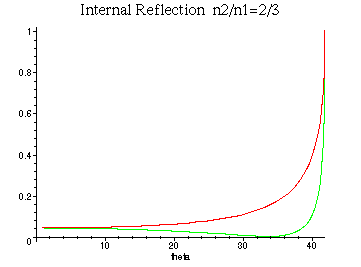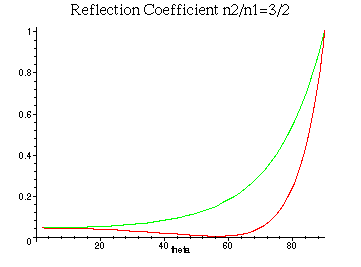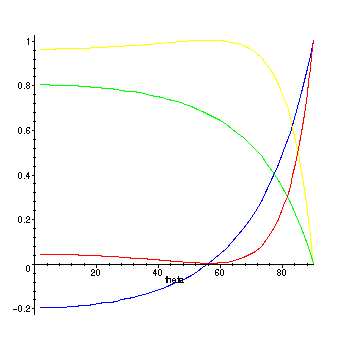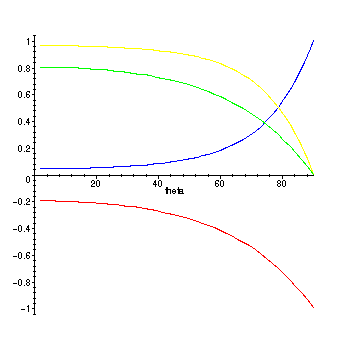First, we consider Internal Reflection. The light is incident from a dense medium
such as water with index of refraction n1 and passes into a less dense medium with
index of refraction n2 < n1. In this case, Snell's law limits the
possible incident angles for refraction to
theta < arcsin(n2/n1). This is called the angle of total
reflection. Beyond this angle, all incident light is reflected!
>
n_1 := 3/2;
![[Maple Math]](images/reflect1.gif)
>
n_2 := 1;
![[Maple Math]](images/reflect2.gif)
>
phi := theta*Pi/180;
![[Maple Math]](images/reflect3.gif)
>
xi := arcsin(n_1*sin(phi)/n_2);
![[Maple Math]](images/reflect4.gif)
>
Theta_max := 180*arcsin(n_2/n_1)/Pi;
![[Maple Math]](images/reflect5.gif)
>
R_perp:= (sin(xi-phi)/sin(xi+phi))^2;
![[Maple Math]](images/reflect6.gif)
>
R_para:= (tan(xi-phi)/tan(xi+phi))^2;
![[Maple Math]](images/reflect7.gif)
>
plot({R_perp,R_para},theta=0..Theta_max,title="Internal Reflection n2/n1=2/3");
In green, we plot the reflection coefficient for parallel
polarization and in red, we plot the coefficient for perpendicular
polarization. The angle at which R|| = 0 is called Brewster's angle. Note that
both coefficients = 1 at the angle of total reflection.

Next, we consider light incident from a less dense medium
such as air with index of refraction n1 passing into a dense medium such as
glass with index of refraction n2 > n1.
>
n_1 := 1;
![[Maple Math]](images/reflect9.gif)
>
n_2 := 3/2;
![[Maple Math]](images/reflect10.gif)
>
phi := theta*Pi/180;
![[Maple Math]](images/reflect11.gif)
>
xi := arcsin(n_1*sin(phi)/n_2);
![[Maple Math]](images/reflect12.gif)
>
R_perp:= (sin(xi-phi)/sin(xi+phi))^2;
![[Maple Math]](images/reflect13.gif)
>
>
R_para:= (tan(xi-phi)/tan(xi+phi))^2;
![[Maple Math]](images/reflect14.gif)
>
plot({R_perp,R_para},theta=0..90,title="Reflection Coefficient n2/n1=3/2");
In green, we plot the reflection coefficient for
perpendicular
polarization and in red, we plot the coefficient for parallel
polarization. Again, the angle at which R|| = 0 is called Brewster's angle.
Note that
both coefficients = 1 at 90 degrees. Does it surprise you that in both examples the
two reflection coefficients = 0.04 when theta=0?

Now, let's look at the amplitudes. First we consider parallel incidence:
>
Er_para := tan(xi-phi)/tan(xi+phi);
![[Maple Math]](images/reflect16.gif)
>
Et_para := n_1*(1-Er_para)/n_2;
![[Maple Math]](images/reflect17.gif)
>
plot({Er_para,Et_para,R_para,1-R_para},theta=0..90);
The blue curve is the relative amplitude of the reflected
wave, the green curve is the relative amplitude of the
transmitted wave, the red curve is the reflection coefficient,
and the yellow curve is the transmission coefficient.
All of these are for parallel incidence.

Finally, we consider amplitudes for perpendicular incidence:
>
Er_perp := sin(xi-phi)/sin(xi+phi);
![[Maple Math]](images/reflect19.gif)
>
Et_perp := 1+Er_perp;
![[Maple Math]](images/reflect20.gif)
>
>
plot({Er_perp,Et_perp,R_perp,1-R_perp},theta=0..90);
The red curve is the relative amplitude of the reflected
wave, the green curve is the relative amplitude of the
transmitted wave, the blue curve is the reflection coefficient,
and the yellow curve is the transmission coefficient.
All of these are for perpendicular incidence.

![]()
![]()
![]()
![]()
![[Maple Math]](images/reflect5.gif)
![[Maple Math]](images/reflect6.gif)
![[Maple Math]](images/reflect7.gif)

![]()
![]()
![]()
![]()
![[Maple Math]](images/reflect13.gif)
![[Maple Math]](images/reflect14.gif)

![[Maple Math]](images/reflect16.gif)
![[Maple Math]](images/reflect17.gif)

![[Maple Math]](images/reflect19.gif)
![[Maple Math]](images/reflect20.gif)
